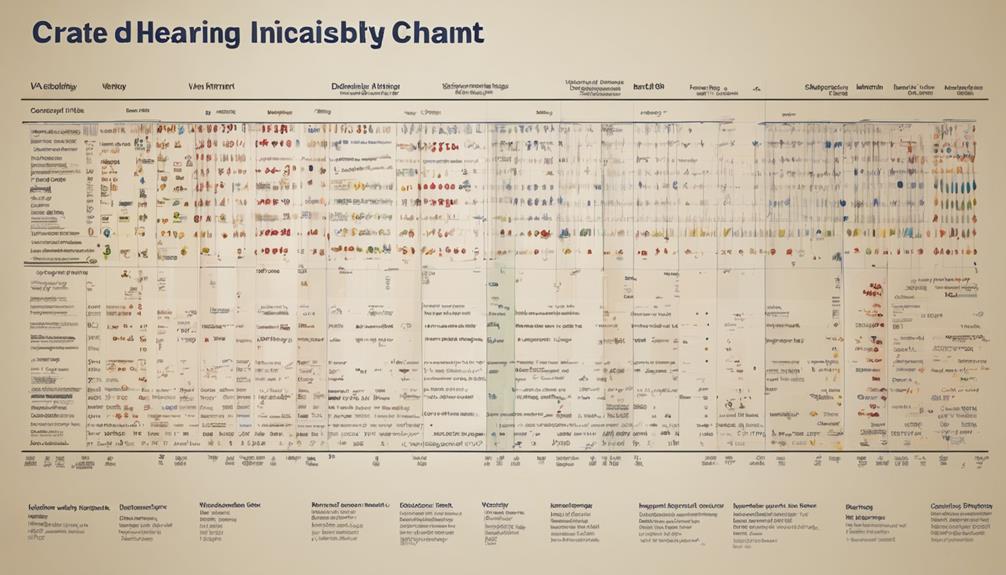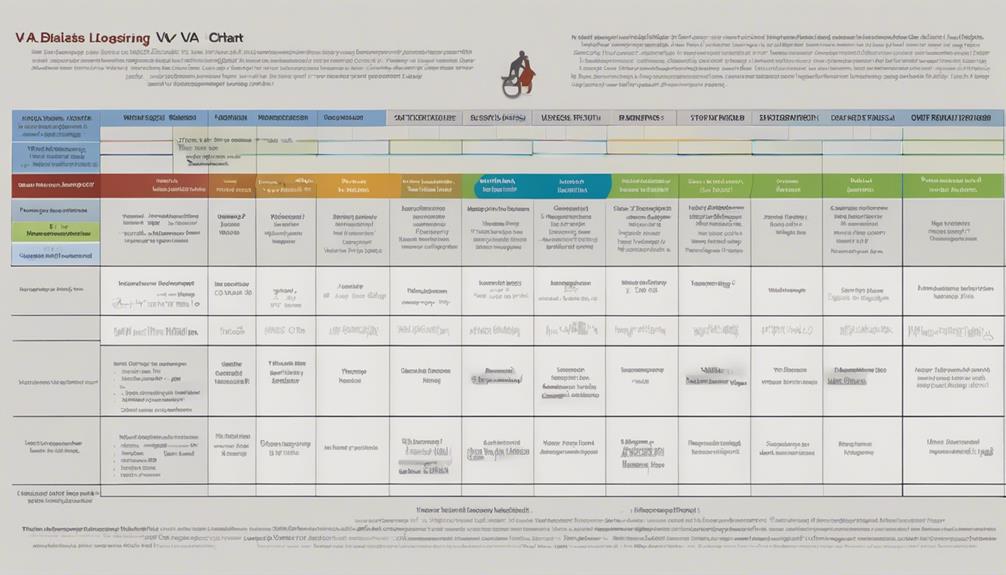Are you interested in learning more about the details on the VA Disability Hearing Loss Chart?
The intricacies of this chart can be complex, yet understanding it is key in grasping the implications for veterans seeking disability benefits.
The chart serves as a crucial tool in determining the severity of hearing impairment for veterans, ultimately impacting the level of disability compensation they may receive.
The implications of these ratings extend far beyond mere numbers, influencing various aspects of a veteran's life.
Understanding how this chart operates can significantly alter the course of a veteran's benefits journey.
Key Takeaways
- The chart determines disability ratings from 0 to 100 based on specific tests.
- Disability ratings reflect the severity of hearing loss for veterans.
- The chart aids in accurately categorizing levels of hearing impairment.
- It plays a crucial role in determining fair compensation amounts for veterans.
Understanding VA Disability Hearing Loss Chart
In assessing hearing impairment for veterans, the VA Disability Hearing Loss Chart utilizes Roman numeral designations based on specific tests to determine disability ratings ranging from 0 to 100. This chart plays a crucial role in evaluating the severity of hearing loss in veterans, providing a standardized method to assign disability ratings accurately.
By comparing the results of various hearing tests to the designated Roman numerals on the chart, healthcare professionals can determine the appropriate disability rating for each veteran. Understanding the VA Disability Hearing Loss Chart is essential for veterans as it gives them insight into how their hearing loss is being assessed and the corresponding disability rating assigned.
Interpreting Disability Ratings

Transitioning to the current subtopic, we move from understanding the VA Disability Hearing Loss Chart to interpreting disability ratings based on the severity of hearing loss determined by specific tests. When interpreting disability ratings from the VA Disability Hearing Loss Chart, it's crucial to consider the following:
- The ratings are determined by the results of specific hearing tests.
- The chart provides a Roman numeral designation for the level of impairment detected.
- Veterans may receive a single rating, even in cases of bilateral impairment.
- The assigned rating reflects the severity of hearing loss and assists in determining appropriate compensation for veterans with hearing disabilities.
Understanding these key points is essential for accurately assessing the impact of hearing loss on veterans and ensuring they receive the appropriate support and compensation they deserve. By interpreting the disability ratings, VA officials can effectively gauge the level of impairment and provide the necessary assistance to those who've served our country.
Impact on Compensation Claims
The impact of the VA Disability Hearing Loss Chart on compensation claims for veterans with hearing impairment is significant and directly correlates with the assigned disability rating. The severity of hearing loss, as indicated by the chart's Roman numeral designation, plays a crucial role in determining the compensation amount veterans may receive.
By using a grid system to categorize the level of hearing impairment, the chart helps assess the impact of hearing loss on veterans' disability claims. This assessment is pivotal in ensuring that veterans are fairly compensated for the challenges they face due to their hearing impairment.
Understanding the VA Disability Hearing Loss Chart allows for a more accurate evaluation of the extent of disability experienced by veterans, leading to a more equitable distribution of compensation based on the severity of their condition. Therefore, the chart serves as a vital tool in the compensation process for veterans with hearing impairment.
Navigating Hearing Loss Levels

Navigating the levels of hearing loss within the VA Disability Hearing Loss Chart involves understanding the grid system's Roman numeral designations to determine the degree of impairment and corresponding disability rating for veterans.
To effectively navigate the chart, consider the following points:
- Interpreting Test Results: Accurately interpreting your test results and locating them on the chart is crucial for determining your level of hearing impairment.
- Correlating Disability Rating: Each Roman numeral designation on the chart corresponds to a specific disability rating, indicating the extent of compensation you may be eligible to receive.
- Identifying Impairment Levels: The grid system categorizes different levels of impairment, helping veterans understand the severity of their hearing loss.
- Maximizing Compensation: By grasping the chart's layout and how it relates to your test results, you can ensure you're appropriately compensated for your degree of hearing loss.
Understanding the VA Disability Hearing Loss Chart is essential for veterans seeking to navigate the complexities of their impairment levels and potential compensation.
Applying for VA Benefits
When applying for VA benefits related to hearing impairment, understanding the VA Disability Hearing Loss Chart is essential for veterans. This chart plays a crucial role in helping veterans navigate the VA claims process by providing a visual representation of disability ratings for hearing loss.
By referring to the chart, veterans can determine their impairment level based on the Roman numeral designation assigned according to their hearing test results. Understanding this designation is vital as it directly correlates to the disability rating assigned to the individual, which, in turn, influences the compensation amount they may receive.
The chart serves as a valuable tool for veterans seeking benefits for hearing loss claims, as it clearly outlines the relationship between impairment severity and the corresponding benefits available. By utilizing the information presented in the VA Disability Hearing Loss Chart, veterans can effectively advocate for the benefits they're entitled to receive.
Frequently Asked Questions
What Does the VA Look for in Hearing Loss?
In evaluating hearing loss, the VA looks for specific test results like pure tone thresholds and speech discrimination. Licensed audiologists play a crucial role in providing evaluations for VA disability claims.
Bilateral hearing loss in both ears is considered when determining disability ratings. The severity of impairment is used to assign a Roman numeral designation on the VA Disability Hearing Loss Chart.
Additional evidence can be submitted by veterans to support claims for a higher disability rating based on VA criteria.
What Is the Most Common VA Rating for Hearing Loss?
We often see a 10% VA rating for hearing loss, which is quite common among veterans. This rating is typically given to those with some level of hearing impairment.
VA uses specific tests to assess the severity of hearing loss, which can range from 0% to 100% based on the degree of impairment.
Supporting evidence may be necessary for a higher disability rating.
What Is the C&P Exam for Hearing Loss?
The C&P exam for hearing loss is a comprehensive evaluation conducted by a licensed audiologist. This exam includes speech discrimination and puretone audiometry tests to determine the severity of hearing loss and establish disability ratings.
These results are crucial for assessing how hearing loss impacts daily functioning. Specific criteria and measurements are used during the exam to provide an accurate evaluation of hearing impairment.
The exam results are pivotal in the VA's decision-making process for awarding disability benefits.
How Do You Calculate Hearing Loss Disability?
We calculate hearing loss disability by analyzing results from the Puretone Audiometry Test. Frequencies at 1000, 2000, 3000, and 4000 Hertz for both ears are considered, along with Controlled Speech Discrimination Results for each ear.
Additional evidence, like lay testimonies, can bolster a claim for a higher disability rating. It's a meticulous process that ensures accurate assessment of hearing impairment and appropriate support for our veterans.
Conclusion
In conclusion, the VA Disability Hearing Loss Chart clearly categorizes levels of impairment for veterans seeking compensation. Understanding and interpreting these ratings can significantly impact the outcome of compensation claims.
Navigating the various levels of hearing loss is crucial in applying for VA benefits. Ultimately, the chart serves as a key tool in assessing and determining the extent of disability for veterans, ensuring they receive the appropriate support and compensation they deserve.











